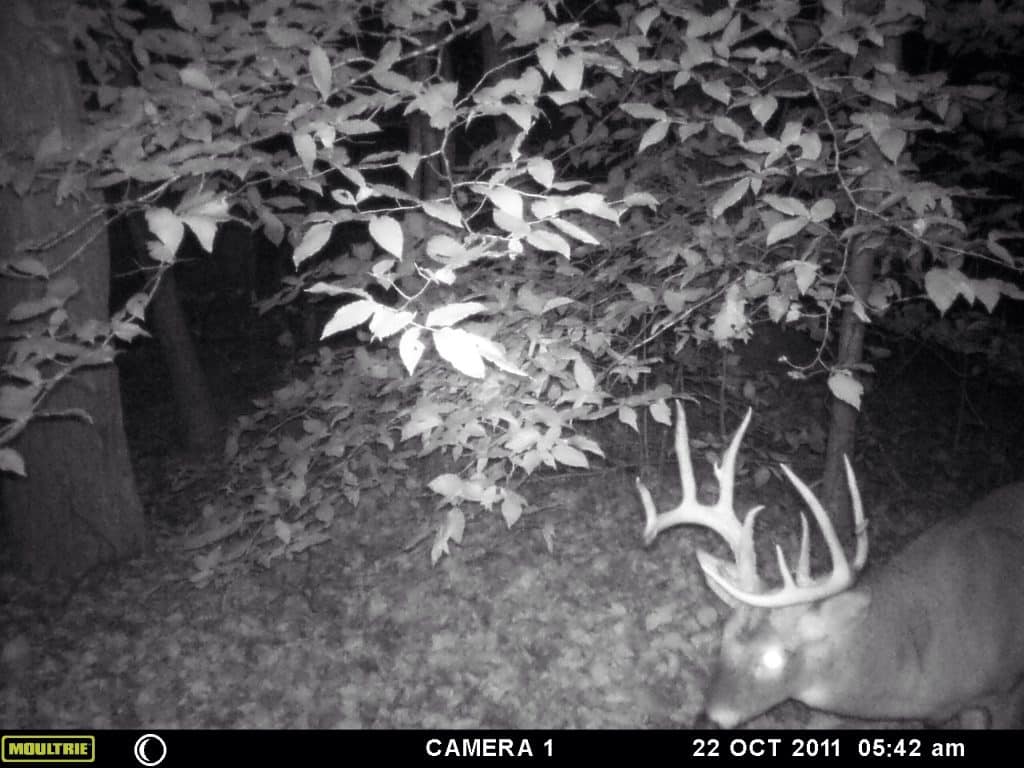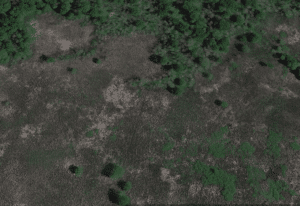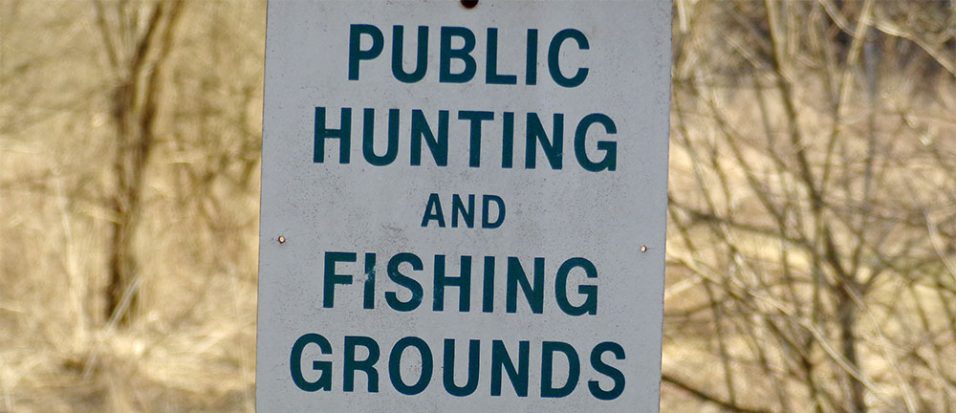The odds of a whitetail buck making it to a 4th breeding season on public land here in Michigan are low, so there aren’t many around. Consequently, it’s difficult, but not impossible to consistently get on mature deer while hunting public land. The key to consistency? Understanding how those few bucks that do make it manage to beat the odds.
Darwin’s theory of natural selection is, “The principle by which each slight variation of a trait, if useful, is preserved.”
Translation… develop the right habits and live… don’t and get eaten.
Understanding Big Public Land Whitetails
To consistently find them, you first need to understand them. Bottom line, mature whitetails on pressured public and private land react to danger by developing habits and seeking locations that minimize or eliminate their exposure to it… that simple. That’s why the overwhelming majority of mature bucks killed on public land are on 1st sits in sets hung during spring scouting or hang and hunts. Can you get lucky? Yes, but I don’t count on it. For example, if you’re hunting a bedding area in the evening and don’t connect, he’s going to cut your ground scent after you’re gone and adapt to your intrusion by sitting tight until well after dark, exit the bedding area by a different trail or relocate to another bedding area. Game over. That’s how they survive.
The bucks that don’t adapt to human intrusion in their core areas get shot. The deer that regularly move during shooting light past the range of what they could hear, see and smell from their bed get shot. The bucks that regularly chase does far and wide in daylight get shot.
We know how they adapt, now how do you find them?

Mature buck habits? This public hunting land stomper was headed into a marsh bedding area 2 hours before shooting light.
Cyber Scout for Efficiency
Google Earth is the great equalizer when it comes to bow hunting public land. I’m still surprised how few deer hunters regularly use it for scouting. I use it to identify deer trails, potential bedding areas, islands and high spots in marshes and swamps and hunter access points in particular. I’m also looking for food plots or ag fields on adjacent private land. That’s an ideal situation, because in most cases the private land gets hunted far harder than the interior of the adjacent public marsh or swamp, and that’s where the mature deer go to avoid the pressure, moving back onto the private for groceries after dark.
I’m primarily interested in hunting public land parcels that are landlocked by private, have very difficult access and are really wet. I prefer to access by water so I’m looking for ditches, creeks, and rivers that I can use to get to the interior of the property without leaving ground scent. Once you start reconciling what you see on Google Earth with what you find when you walk the ground, you’ll be able to identify trails, subtle elevation changes, potential bedding areas, tall grass vs cattails, small stands of oak trees on islands, and high spots right from your kitchen table. Here’s the link to download Google Earth.
Also, using a hunt mapping app like OnXMaps can help you find unposted, landlocked, or lightly pressured public hunting lands. Check out https://nextbukoutdoors.com/public-land-deer-hunters-onxmaps/ to learn more about how OnXMaps can help you close the distance on big public land whitetails.
Hunting Public Land? Think Marshes!
I love bow hunting marshes! From huge river system marshes to small 2 acre marshes in the middle of a section of woods, what they have in common is pressure completely around them, but generally not IN THEM. Before I dive into a new marsh I pick it apart on Google Earth and identify everything that isn’t cattails. Deer bed on dry ground, so I’m looking for vegetation changes, islands, high spots, and trees…anything that looks like dry ground. Trees need dry ground to grow on and their raised root clusters provide bedding spots, so any trees are of particular interest. Also, places where I see tall grass instead of cattails are noted. I thoroughly scout every marsh I find on public land. There may be a 100 trees, humps and high spots to investigate in a 50 acre marsh. I look at all of them. The VAST majority will have few if any active mature buck beds, but I only need to find 1. Our Hunting Marsh Bucks DVD breaks down how to effectively scout marshes, find big buck beds and develop a game plan so you have the confidence to go in and make it happen.
Why Do I Love Bowhunting Marshes?
- Interiors are accessible only by boat, canoe or waders
- Few trees and and even fewer tall or straight trees
- Difficult to navigate in the dark
- Takes considerable effort to scout, hunt and drag deer through
- I don’t see other people!
The overwhelming majority of folks that are bow hunting public land don’t want to, or flat out can’t get out to hunt in this type of environment. That’s why mature bucks end up there. This study maps out hunter densities and clearly shows how little effort most hunters are willing to put forth when hunting public land. Eye opening information!
The downside to bow hunting marshes is that if the water level goes up, most if not all buck bedding areas can be under water. How do you combat that? Have a lot of marshes to hunt. Marshes that are connected to river systems will drain a lot quicker than marshes without an outlet.

In this Google Earth image, the trail runs N/NW from the buck bedding area toward the high ground. Just downwind of where the trail hits the finger of high ground is where you need to be.
Hunting Public Land Whitetails and Lack of Sign
We all get fired up when we find huge rubs. Well, consider Darwin’s theory of natural selection again as it pertains to bucks making rubs. The buck that is genetically pre-disposed to leaving a rub line a blind man could follow and blowing up trees all over makes him pretty easy to find doesn’t it? Rarely will I find a mature buck on public ground that is leaving a lot of sign in the form of rubs. I spend a lot of time bow hunting marshes and in most cases, there just aren’t a lot of trees so rubs are few and far between, anyway. So, if you don’t find a lot of big rubs and scrapes, keep looking. Look for any areas that have a concentration of new and old rubs on big trees. The older ones will look like an elongated wound in the tree and will move up the tree as it grows. When you find spots like this, stop, look around and ask yourself why here? Is this staging for a bed or bedding area I haven’t found yet, or is it a cruising or terrain funnel that concentrates buck activity? If there are no fresh rubs, but a lot of old rubs going back several years make a note to check it the following year. Concentrations of mature buck historical sign is gold. If that spot was attractive to one mature buck, it will be attractive to others.
Besides rubs, I’m looking for 3-4 finger wide walking tracks and big, isolated beds. Tracks are hugely important because no matter how reclusive a deer is and how little rubbing or scraping he does, he can’t defeat gravity. Great place to check for tracks is where trails come out of a marsh onto high ground. The ground typically is soft and you’ll get good, detailed impressions.
Well, hope this was helpful and got your wheels turning thinking about hunting public land for mature whitetails.
We always love to hear how other public land hunters are getting it done on big deer, so shoot us your comments and tips!

This is very helpful because I hunt only on public land. I believe that killing a mature buck takes a lot of work.
I personally have never gone on a hunting trip. But after reading this article, it kind of made me curious a little bit how it feels to go on one. You mentioned about how you love bow hunting marshes and the things that you look for such as vegetation changes, islands, and trees. I suddenly felt the urge to be part of a hunting trip and see these things for myself. I will definitely try this one out for sure. It should be adventurous! Thanks.